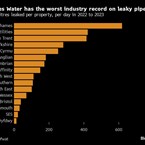The data foundation imperative for energy
By: Silvia Rigato, Strategy Managing Director and Middle East Energy lead at Accenture
Today, there are a new set of priorities for the oil and gas industry. These are primarily driven by the looming global shift from fossil fuel-based to renewable energy sources. Future growth amid this energy transition requires a total transformation of cost structures with new customer-centric operating models, the maximisation of every molecule’s value across the value chain, and the use of data as an engine of growth.
Industry leaders are starting to invest in new data capabilities, artificial intelligence (AI) solutions and cloud infrastructures to help them gather, process, and use the information at their disposal. But thus far, they’ve captured just a fraction of their data’s value.
To enable better, faster decisions at this critical juncture, energy companies must embark on (or accelerate) their intelligent enterprise data journeys. With the energy transition fast approaching, there’s not a moment—or data-driven insight—to waste.
Mind the gap. Then close it.
A small number of leading energy players are aggressively investing in what it takes to get their data houses in order. They are unlocking the potential of analytics by overcoming the data foundation maturity chasm. Yet, for most energy companies, the promise of clean, connected data and end-to-end AI-enabled business intelligence has not materialised. Why? Because companies’ data foundations and operating models have not, however, achieved the maturity required.
Five constraints typically cause these maturity gaps. Analytics leaders are free from these:
Data is generally not considered an essential element of business strategy. An integrated data strategy must be in place to support the new business strategy. In many cases, the data strategy and business strategy will be indistinguishable.
Data platforms and connectivity are typically viewed as IT issues, not a business priority. Data siloes, complex tooling, and monolithic architectures constrain energy companies’ ability to perform cross-functional analytics.
Data governance is ill-defined or inconsistently applied. Most oil and gas companies still operate in a siloed manner. Enterprise-wide data practices and usage/security protocols are quite rare.
Data literacy is low. New skills will be needed to align with these capabilities and governance.
Change management is under-appreciated. Enterprise-wide adoption of analytics, AI, and other data tools represent a significant cultural change within an organisation.
With these foundational elements in place, an oil and gas company can enter the final stretch of its intelligent enterprise data journey. Advanced AI solutions can be deployed to overcome previously insurmountable hurdles. Entirely new ways of working can be implemented based on new AI-driven insights.
This is when the organisation finally realises the full potential of its data.
There are six key attributes of an intelligent data foundation:
Provide rapid access to priority data sets. Bring together the set of diverse, prioritized data sets that will unlock trapped value when blended.
Enable data exploration. Make data searchable and provide the tooling and collaboration capabilities to create cross-functional insight that unlocks trapped value.
Augment data trust and usability. Enable addition of business context to data, boosting its usability, and provide visibility of its changes from the point of origination to consumption, boosting trust in data.
Deliver a fast-path from ideation to deployment. Deploy a flexible ‘data supply chain’ architecture underpinned by modern platform architecture and engineering for a fast, scalable production path.
Implement data security and privacy by design. Combine risk plus value lenses to secure critical data, implementing data security and privacy controls without impacting data exploration.
Apply innovations in platforms, engineering, and AI. Continuously innovate, implementing a combination of cloud platforms, modern data and machine learning engineering, and AI techniques to enable speed, automation, and agility.
Data for speed Data at speed
While the energy industry has lagged others on the journey to data maturity, energy companies now have the chance to close the gap. With the right focus and investment, they can leap forward with their data and analytics transformations and achieve within 12 to 18 months what would have taken more than five years in the past.
Energy companies can start taking steps today to accelerate the transformation that is needed. They can develop an analytics vision by including use cases with aspirational performance improvement targets across the enterprise. They can also perform an audit across the five key capabilities and identify the most critical gaps to deliver the vision. And finally, they can design a robust operating model and encourage the use of analytics and new ways of working.
Harnessing data and AI is not a luxury anymore. It is a matter of survival. The question is no longer “when should we start?” but “how fast can we get it done?”
KEEPING THE ENERGY INDUSTRY CONNECTED
Subscribe to our newsletter and get the best of Energy Connects directly to your inbox each week.
By subscribing, you agree to the processing of your personal data by dmg events as described in the Privacy Policy.

Chevron helping drive Egypt’s journey to become Africa’s energy powerhouse
Mar 11, 2024
Energy Workforce helps bridge the gender gap in the industry
Mar 08, 2024
EGYPES Climatech champion on a mission to combat climate change
Mar 04, 2024
Fertiglobe’s sustainability journey
Feb 29, 2024
P&O Maritime Logistics pushing for greater decarbonisation
Feb 27, 2024
India’s energy sector presents lucrative opportunities for global companies
Jan 31, 2024
Oil India charts the course to ambitious energy growth
Jan 25, 2024
Maritime sector is stepping up to the challenges of decarbonisation
Jan 08, 2024
COP28: turning transition challenges into clean energy opportunities
Dec 08, 2023
Why 2030 is a pivotal year in the race to net zero
Oct 26, 2023Partner content

Ebara Elliott Energy offers a range of products for a sustainable energy economy

Essar outlines how its CBM contribution is bolstering for India’s energy landscape

Positioning petrochemicals market in the emerging circular economy

Navigating markets and creating significant regional opportunities with Spectrum




























